- 您的位置:
- 标准下载网 >>
- 标准分类 >>
- 商检行业标准(SN) >>
- SN/T 2060-2008 进出口蜂王浆中泰乐菌素残留量测定方法酶联免疫法
标准号:
SN/T 2060-2008
标准名称:
进出口蜂王浆中泰乐菌素残留量测定方法酶联免疫法
标准类别:
商检行业标准(SN)
标准状态:
现行-
发布日期:
2008-04-29 -
实施日期:
2008-11-01 出版语种:
简体中文下载格式:
.rar.pdf下载大小:
881.28 KB
标准ICS号:
食品技术>>67.050食品试验和分析的一般方法中标分类号:
食品>>食品综合>>X04基础标准与通用方法
部分标准内容:
中华人民共和国出入境检验检疫行业标准SN/T2060—2008
进出口蜂王浆中泰乐菌素残留量测定方法
酶联免疫法
Determination of tylosin residues in royal jelly for import and export-Enzyme-linked immunosorbent assay2008-04-29发布
中华人民共和国
国家质量监督检验检疫总局
2008-11-01实施
中华人民共和国出人境检验检疫行业标准
进出口蜂王浆中泰乐菌素残留量测定方法酶联免疫法
SN/T20602008
中国标准出版社出版
北京复兴门外三里河北街16号
邮政编码:100045
网址spc.net.cn
电话:6852394668517548
中国标准出版社秦皇岛印刷厂印刷开本880×12301/16印张1字数23千字2008年7月第一版2008年7月第一次印刷印数1-2000
书号:155066·2-18924
定价10.00元
本标准的附录A为资料性附录。
本标准由国家认证认可监督管理委员会提出并归口。本标准起草单位:中华人民共和国浙江出入境检验检疫局。本标准主要起草人:施伟良、张晓峰、黎昊雁、朱振江、何永强本标准系首次发布的出入境检验检疫行业标准SN/T2060—2008
1范围
进出口蜂王浆中泰乐菌素残留量测定方法酶联免疫法
本标准规定了蜂王浆和王浆冻干粉中泰乐菌素残留量的酶联免疫测定方法本标准适用于蜂王浆和王浆冻干粉中泰乐菌素残留量的测定2规范性引用文件
SN/T2060—2008
下列文件中的条款通过本标准的引用而成为本标准的条款。凡是注明日期的引用文件,其随后所有的修改单(不包括勘误的内容)或修订版均不适用于本标准,然而,鼓励根据本标准达成协议的各方研究是否可使用这些文件的最新版本。凡是不注明日期的引用文件,其最新版本适用于本标准。GB/T6682分析实验室用水规格和试验方法(GB/T6682—1992.neqISO3696:1987)3方法提要
本标准以酸性的庚烷磺酸钠缓冲液来提取蜂王浆中残留的泰乐菌素,沉淀王浆中蛋白后并调节PH至7.0。处理后样品中残留的泰乐菌素与酶标记泰乐菌素共同竞争结合至包被在微孔板上的绵羊抗兔抗体,通过洗涤除去未结合的泰乐菌素和酶标记泰乐菌素,然后加入底物显色,用酶标仪测定吸光度,根据吸光度值得出试样中泰乐菌素的含量。4试剂和材料
除注明外,所有试剂均为分析纯:水为GB/T6682规定的一级水4.1泰乐菌素检测试剂盒(参见附录A)。4.2庚烷磺酸钠缓冲液:称取10.1g庚烷磺酸钠[CH(CHz),SO,Na],11.4g磷酸钠(Na;PO4·12H2O)用水溶解并定容到1L.用磷酸调节pH至2.0。4.3磷酸盐缓冲液:称取磷酸钠(NazHPO,·12HO)34g,用水溶解并定容到1L,调节pH至8.0。4.4HLB小柱,Oasis(或相当产品),3mL(60mg)。4.5泰乐菌素标准品:纯度大于等于98%。4.6泰乐菌素标准品溶液的配制:用甲醇作为溶剂配制成400μg/mL的储存液,于一20℃条件下保存。
5仪器和设备
酶标仪。
2八道移液器:10μ~100μL。
5.3单道移液器:10μL~100μL,100μL~1000μL和2mL~10mL,5.4混合振荡器。
5.5高速低温离心机:6000r/min5.6具塞试管:50mL。
5.7电子天平:0.01g~100g。
5.8酸度计。
SN/T2060—2008
6试样的制备与保存
6.1试样的制备
原始样品总量不得少于200g,蜂王浆充分搅拌均匀后,将样品分成两等份;冻干粉采用四分法,将样品分成两等份。分好的样品装人洁净容器、加封并做标识,6.2试样的保存
将样品于20℃~-18℃条件下保存。7分析步骤
7.1提取
称取2.0g蜂王浆样品,置于50mL具塞试管中,加入6mL庚烷磺酸钠缓冲液(4.2),充分振荡15℃条件下6000r/min离心10min,取0.5mL上清液于二干净试管,加入0.5mL磷酸盐缓冲液(4.3),混合均匀,调节pH至6.8~7.2,此溶液即可供ELISA检测用。最后样品稀释倍数为8。王浆冻干粉则用水以1:2比例稀释,充分浸泡(2h以上)后,称取2.0g按照上述王浆前处理方法进行提取,最后稀释倍数为24。
7.2测定条件1)
7.2.1操作条件
所有操作应在室温下(20℃~24℃)进行,泰乐菌素试剂盒中所有试剂的温度均应回升至室温(20℃~24℃)后方可使用。
7.2.2洗板条件
人工洗涤次数5次以上,每次加入洗涤液量为250L:自动洗板可以预定5次7.2.3酶标仪测定条件
酶标仪测定波长为450nm
7.3测定步骤
7.3.1将测定需用的微孔板备齐并插人微孔架上,记录标准品及样品等在微孔架上的位置7.3.2吸取50μL泰乐菌素标准溶液(浓度分别为:0、0.3、0.6、1.25、2.5、5、10、25ng/mL)于孔Al、A2—H1、H2;吸取50μL样品溶液于其余微孔中。7.3.3吸取100μL泰乐菌素酶标记物溶液于每一个微孔。用封口膜封孔条,并持微孔板在台面上以圆周运动方式混匀,室温(20℃~24℃)下避光温育10min(温育过程中晃动/振动反应板)。7.3.4倒出孔中的液体,将微孔架反扣在吸水纸上反复拍打,以除去孔中过多的残液,用洗涤缓冲液洗板6次。
7.3.5迅速加入100L底物溶液于每一个微孔底部,然后,持微孔板在台面上以圆周运动方式混匀后,室温(20℃~24℃)下避光温育10min。7.3.6迅速加人100μL反应终止液于每一个微孔,然后,持微孔板在台面上以圆周运动方式混匀后,将微孔架置于酶标仪中,在450nm处测量吸光度(加人反应终止液后应在30min内读取吸光度)。
7.4平行试验
按以上步骤,对同一标准溶液、同一样品溶液均应进行平行试验测定。7.5空白试验
除不称取试样外,均按上述步骤进行。1)给出该信息是为了方便本标准的使用者.并不表示对某一产品操作步骤的认可。如果其他产品的操作步骤有不同,需经实验评估后采用。
7.6阳性质控
SN/T2060—2008
每次测定均应做一个添加自配泰乐菌素标准品溶液(4.6)的监控样品。以确定实验过程的操作准确性。
结果计算
标准品和样品的OD平均值除以零标准(A1、A2)的平均OD值,再乘以100,计算出各标准液和样品的百分比吸光度值。零标准为100%(最大吸光度值),其他OD值为最大吸光度值的百分数以吸光度的百分比值(B/B)为纵坐标(%),泰乐菌素标准溶液浓度(ng/mL)的对数值为横坐标,绘制标准工作曲线。从标准工作曲线上得到试样中相应的泰乐菌素浓度后,结果按式(1)进行计算:X=cXVx1000
mX1000
式中:
X——样品中泰乐菌素的残留量,单位为微克每千克(μg/kg);从标准工作曲线上得到的样品中泰乐菌素浓度,单位为纳克每毫升(ng/mL);V—样品溶液的最终定容体积,单位为毫升(mL);-样品溶液所代表的最终试样质量,单位为克(g)m
也可以用各种酶标仪的数据处理软件进行计算。所得结果表示至一位小数、确证试验
如被测样品中泰乐菌素残留量的值大于限量要求时,应用其他方法进行确证。10
本方法测定低限和回收率
10.1检测低限
本方法的检测低限为10ug/kg。
10.2回收率
本方法泰乐菌素添加浓度和回收率实验数据:一添加量为10μg/kg时,回收率为73%~97%;一添加量为100μg/kg时,回收率为82.7%~113.7%;添加量为500ug/kg时,回收率为87.4%112.8%..(1)
SN/T2060—2008
A.1试剂盒组成
附录A
(资料性附录)
泰乐菌素试剂盒(杭州迪恩科技有限公司产品)2)A.1. 1
预包被抗体的96孔板:12条×8孔。A.1.2
泰乐菌素标准溶液:100ng/mL
泰乐菌素酶标记物溶解液。
泰乐菌素酶标记物冻干粉:根据泰乐菌素试剂盒中说明,可用酶标记物溶解液配制成泰乐菌素A.1.4
酶标记物溶液。
A.1.5显色剂。
稀释液:根据泰乐菌素试剂盒中说明,可用蒸馏水10倍稀释后使用。A.1.7
洗涤浓缩液(10倍浓缩):可用水稀释后使用。A.1.8
反应终止液。
试剂盒应在4℃~8℃避光条件下保存。A.2标准校正曲线
标准校正曲线见图A.1。
y=-0.1387lnr+0.5283
R2-0.9938
c(ng/inL)
图A.1:
标准校正曲线
2)给出该信息是为了方便本标准的使用者,并不表示对某一产品的认可。如果其他产品具有相同的效果,需经实验评估后使用这些等效产品。
Foreword
TheannexAof this standard is an informativeannexSN/T2060—2008
This standard was proposed by and is under the charged of certification and accreditation administation of the People's Republic of China.ThisstandardwasdraftedbyZhejiangEntry-ExitInspectionandQuarantineBureau.The standard was mainly drafted by Wei-liang Shi, Feng-xiao Zhang, Hao-yan Li,Zhen-jiang Zhu,Yong-qiang He.
This standard is a professional standard for entry-exit inspection and quarantine promulgated for thefirsttime.
SN/T2060—2008
1Scope
Determination of tylosin residuesinroyaljellyforimportandexportEnzyme-linkedimmunosorbentassayThis standard specifies the methods of determination by ELiSA method of tylosin residues in royaljellyandroyal jellypowder.
This standard is applicable to the screen determination of tylosin residues in royal jelly and royal jellypowder.
2Normativereferences
The following normative documents contain provisions which,through reference in this text,consti-tute provisions of this standard. For dated references,subsequent amendments to,or revisions of,any of these publications do not apply.However parties to agreements based on this standard are en-couraged to investigate the possibility of applying the most recent editions of the normative docu-ments indicated below.For undated references,the latest edition of the normative document referredto applies.
GB/T6682Waterforanalytical laboratoryuse—Specificationandtestmethods(GB/T6682—1992)neqiso36961987)
3Principle
Theassay is performed in a polystyrene microplate,coated with anti-tylosin antibody,which consti-tute the solid phase. The standards,the samples and the enzyme conjugate are added to the micro-plate wells.During the first incubation,there is a competition among the free molecules,like tylosin,the standards or samples and the enzyme(enzyme conjugate)for the binding sites of the anti-tylosinantibody adsorbed to the solid phase. After the washing step,any unbound molecule is removed. Thebound enzyme activity is determined by adding an amount of chromogen substrate. The enzyme con-verts the colorless chromogen intoa colored(blue)product.Theadditionof the stop reagent leads toa color change from blue toyellow.Theabsorbance,measured by amicroplate reader(450 nm),is in-verselyproportional totheconcentrationof corticosteroidsinthesample4
Reagentsandmaterials
Unless otherwise specified,all the chemical reagents should be A.R.grade.water is the first grade6
waerprescrikedinGB/T6682.
SN/T 2060—2008
Enzyme immunoassaykitforthequantitativeanalysis of tylosinseeannexA.Heptane sulfonic acid sodium salt buffers:Weigh Heptane sulfonic acid sodium salt [CH(CH,)SO,NaJ10.1gandNa,PO412H,011.4g,dissolvewithwaterto standard solutionof1L,ad-just pH to 2. 0 using H, PO4.4.3
Phosphatebuffer:Weigh34gNa,HPOg·12H,O.dissolvein1Lwater.adjustpHto8.0.HLBcolumns:Oasis,3mL(60mg)
Tylosinstandard(Lyophilized):Purity>98%Thepreparationof tylosinstandardsolution(400μg/mL):storesampleat-20℃.Apparatus and equipment
ELISAreaderequippedwitha450nmfilter5.2
10μL~100μLmultichannel micropipettewith suitable tips.variablevolume precisionmicropipette with suitable tips:10μL~100μL100 μL~1000 μL and2 mL~10 mL.
Saker votex.
Centrifuge:6000r/min.
Testtubewithplug:50mL
Electronicbalance:0.01g~100gpHmeter.
Preparationandstorageofsample6.1
PreparationofsampleextractionThe whole primary sample should be more than 200 g. For royal jelly samples:Divide it into two equalparts after mix well.For royal jelly powder samples:Divide it into two equal parts byquartation.Thenkeepthepreparedsampleintotwosamplebottles,sealandlabel.SN/T2060—2008
Storageof sample
Storesampleat-20℃~-18℃
Analysisprocedure
ExtractionProcedure
Weight2.0gsampleof homogenizedtissueto50mLtesttube.Add6mLHeptanesulfonicacid sodium saltbuffers(4.2).Centrifuge6000r/minat15℃for10min.Put0.5mLsupernatent intoaclean tube,add 0. 5 mL phosphate buffer(4. 3), after vortexing, adjust pH to 6. 8~7. 2 and it's readyforELisAassay.Forroyal jellypowder,itshouldbedipinwater(1:2)atleast2h,thenweigh2.ogforextractionaccordingtoroyal jellymethod.7.2
Test condition'
Operationcondition
All theoperation should be done at room temperature(20℃~24C).The reagents should be brougheuptoambienttemperature(20℃~24℃))beforestartingthetest.7.2.2The work condition of wash machineManual work: All the wells must be washed manually more than 5 times. Each time inject 250 μLwash solution with multichannel micropipette.Automatism work:All the wells should be washed 5timesbythewashmachine.
7.2.3TheworkconditionofmicroplatereaderThemicroplatereadershouldbeusedata450nmfilter7.3Determination
Predetermine an assay layout,recording blank,standard and sample positions,taking intoaccount that all have to be run in duplicate.7.3.2
Add50μLofsampledilutionbufferintotheMaximumBindingwells:Add50μLofeachstandard(0、0.30.6、1.25、2.5、5、10、25ng/mL)intotheassignedstandardwells(A1、A2—H1、H2);Add50μLof eachsample intothesamplewellsThe information supplying herein is just for the convenience usage for the users of this standard and not for1)
some certain product's authorization analysis procedure. The testing process of another equal kits maybe dif-ferso itshouldbeused afttesting.evalution andverification.8
SN/T2060—2008
7.3.3Add 100 μL of conjugate solution in all wells, using the multichannel micropipette. Seal themicrotitre plate and shake the plate gently with rotating motion for few seconds or tap the side ofthe microplate frame 3 or 4 times to mix.Incubate 10 min at room temperature (20℃ ~24℃).Tap-ping the plate to mix should be performed 3 to 5 times within the incubation.7.3.4Pour the liquid out of the wells; remove the remaining droplets by tapping the microplateupside down vigorously against absorbent paper;wash the microplate following the conditionof 7.2.2.
7.3.5Using the multichannel micropipette, add 100 μL of substrate solution into all wells and mixthoroughly with rotating motion for few seconds or tap the side of the microplate frame 3or 4timesto mix.;Incubatefor10min at roomtemperature(20℃~24℃).7.3. 6Add 10o μL of stop solution to each well and mix thoroughly with rotatory motion for fewseconds;measure the absorbance at 450 nm.Read within 30 minutes.7.4Paralleltest此内容来自标准下载网
Following the above steps,the samestandards and sample solutionsalso should be measured at thesametimeforparalleltest.
7.5Blank test
Thetestshouldbedonefollowingtheabovestepsexceptforaddingsamples7.6Positivemonitoring
Analyze a recoveries fortified at maximum residue limit (MRL) level using blank sample each testCalculating the result
The OD values of the standards and the samples(mean values of the duplicates)are divided by themeanOD valueof thezero standard(wellsA1and A2)and multiplyby100(B/B.);the zero stand-ard is thus made equal to 100% (maximal absorbance) and the other OD. values are quoted in per-centages ofthemaximal absorbanceEnter the B/B。values calculated for each standard in a semi-logarithmic system of coordinatesagainst the standard tylosin concentration; draw the standard curve; Interpolate the correspondingconcentration from the calibration curve;Calculate the concentrations of tylosin in the samples ac-cording to formula(1) :
c×V×1000
m×1000
(1)
小提示:此标准内容仅展示完整标准里的部分截取内容,若需要完整标准请到上方自行免费下载完整标准文档。
进出口蜂王浆中泰乐菌素残留量测定方法
酶联免疫法
Determination of tylosin residues in royal jelly for import and export-Enzyme-linked immunosorbent assay2008-04-29发布
中华人民共和国
国家质量监督检验检疫总局
2008-11-01实施
中华人民共和国出人境检验检疫行业标准
进出口蜂王浆中泰乐菌素残留量测定方法酶联免疫法
SN/T20602008
中国标准出版社出版
北京复兴门外三里河北街16号
邮政编码:100045
网址spc.net.cn
电话:6852394668517548
中国标准出版社秦皇岛印刷厂印刷开本880×12301/16印张1字数23千字2008年7月第一版2008年7月第一次印刷印数1-2000
书号:155066·2-18924
定价10.00元
本标准的附录A为资料性附录。
本标准由国家认证认可监督管理委员会提出并归口。本标准起草单位:中华人民共和国浙江出入境检验检疫局。本标准主要起草人:施伟良、张晓峰、黎昊雁、朱振江、何永强本标准系首次发布的出入境检验检疫行业标准SN/T2060—2008
1范围
进出口蜂王浆中泰乐菌素残留量测定方法酶联免疫法
本标准规定了蜂王浆和王浆冻干粉中泰乐菌素残留量的酶联免疫测定方法本标准适用于蜂王浆和王浆冻干粉中泰乐菌素残留量的测定2规范性引用文件
SN/T2060—2008
下列文件中的条款通过本标准的引用而成为本标准的条款。凡是注明日期的引用文件,其随后所有的修改单(不包括勘误的内容)或修订版均不适用于本标准,然而,鼓励根据本标准达成协议的各方研究是否可使用这些文件的最新版本。凡是不注明日期的引用文件,其最新版本适用于本标准。GB/T6682分析实验室用水规格和试验方法(GB/T6682—1992.neqISO3696:1987)3方法提要
本标准以酸性的庚烷磺酸钠缓冲液来提取蜂王浆中残留的泰乐菌素,沉淀王浆中蛋白后并调节PH至7.0。处理后样品中残留的泰乐菌素与酶标记泰乐菌素共同竞争结合至包被在微孔板上的绵羊抗兔抗体,通过洗涤除去未结合的泰乐菌素和酶标记泰乐菌素,然后加入底物显色,用酶标仪测定吸光度,根据吸光度值得出试样中泰乐菌素的含量。4试剂和材料
除注明外,所有试剂均为分析纯:水为GB/T6682规定的一级水4.1泰乐菌素检测试剂盒(参见附录A)。4.2庚烷磺酸钠缓冲液:称取10.1g庚烷磺酸钠[CH(CHz),SO,Na],11.4g磷酸钠(Na;PO4·12H2O)用水溶解并定容到1L.用磷酸调节pH至2.0。4.3磷酸盐缓冲液:称取磷酸钠(NazHPO,·12HO)34g,用水溶解并定容到1L,调节pH至8.0。4.4HLB小柱,Oasis(或相当产品),3mL(60mg)。4.5泰乐菌素标准品:纯度大于等于98%。4.6泰乐菌素标准品溶液的配制:用甲醇作为溶剂配制成400μg/mL的储存液,于一20℃条件下保存。
5仪器和设备
酶标仪。
2八道移液器:10μ~100μL。
5.3单道移液器:10μL~100μL,100μL~1000μL和2mL~10mL,5.4混合振荡器。
5.5高速低温离心机:6000r/min5.6具塞试管:50mL。
5.7电子天平:0.01g~100g。
5.8酸度计。
SN/T2060—2008
6试样的制备与保存
6.1试样的制备
原始样品总量不得少于200g,蜂王浆充分搅拌均匀后,将样品分成两等份;冻干粉采用四分法,将样品分成两等份。分好的样品装人洁净容器、加封并做标识,6.2试样的保存
将样品于20℃~-18℃条件下保存。7分析步骤
7.1提取
称取2.0g蜂王浆样品,置于50mL具塞试管中,加入6mL庚烷磺酸钠缓冲液(4.2),充分振荡15℃条件下6000r/min离心10min,取0.5mL上清液于二干净试管,加入0.5mL磷酸盐缓冲液(4.3),混合均匀,调节pH至6.8~7.2,此溶液即可供ELISA检测用。最后样品稀释倍数为8。王浆冻干粉则用水以1:2比例稀释,充分浸泡(2h以上)后,称取2.0g按照上述王浆前处理方法进行提取,最后稀释倍数为24。
7.2测定条件1)
7.2.1操作条件
所有操作应在室温下(20℃~24℃)进行,泰乐菌素试剂盒中所有试剂的温度均应回升至室温(20℃~24℃)后方可使用。
7.2.2洗板条件
人工洗涤次数5次以上,每次加入洗涤液量为250L:自动洗板可以预定5次7.2.3酶标仪测定条件
酶标仪测定波长为450nm
7.3测定步骤
7.3.1将测定需用的微孔板备齐并插人微孔架上,记录标准品及样品等在微孔架上的位置7.3.2吸取50μL泰乐菌素标准溶液(浓度分别为:0、0.3、0.6、1.25、2.5、5、10、25ng/mL)于孔Al、A2—H1、H2;吸取50μL样品溶液于其余微孔中。7.3.3吸取100μL泰乐菌素酶标记物溶液于每一个微孔。用封口膜封孔条,并持微孔板在台面上以圆周运动方式混匀,室温(20℃~24℃)下避光温育10min(温育过程中晃动/振动反应板)。7.3.4倒出孔中的液体,将微孔架反扣在吸水纸上反复拍打,以除去孔中过多的残液,用洗涤缓冲液洗板6次。
7.3.5迅速加入100L底物溶液于每一个微孔底部,然后,持微孔板在台面上以圆周运动方式混匀后,室温(20℃~24℃)下避光温育10min。7.3.6迅速加人100μL反应终止液于每一个微孔,然后,持微孔板在台面上以圆周运动方式混匀后,将微孔架置于酶标仪中,在450nm处测量吸光度(加人反应终止液后应在30min内读取吸光度)。
7.4平行试验
按以上步骤,对同一标准溶液、同一样品溶液均应进行平行试验测定。7.5空白试验
除不称取试样外,均按上述步骤进行。1)给出该信息是为了方便本标准的使用者.并不表示对某一产品操作步骤的认可。如果其他产品的操作步骤有不同,需经实验评估后采用。
7.6阳性质控
SN/T2060—2008
每次测定均应做一个添加自配泰乐菌素标准品溶液(4.6)的监控样品。以确定实验过程的操作准确性。
结果计算
标准品和样品的OD平均值除以零标准(A1、A2)的平均OD值,再乘以100,计算出各标准液和样品的百分比吸光度值。零标准为100%(最大吸光度值),其他OD值为最大吸光度值的百分数以吸光度的百分比值(B/B)为纵坐标(%),泰乐菌素标准溶液浓度(ng/mL)的对数值为横坐标,绘制标准工作曲线。从标准工作曲线上得到试样中相应的泰乐菌素浓度后,结果按式(1)进行计算:X=cXVx1000
mX1000
式中:
X——样品中泰乐菌素的残留量,单位为微克每千克(μg/kg);从标准工作曲线上得到的样品中泰乐菌素浓度,单位为纳克每毫升(ng/mL);V—样品溶液的最终定容体积,单位为毫升(mL);-样品溶液所代表的最终试样质量,单位为克(g)m
也可以用各种酶标仪的数据处理软件进行计算。所得结果表示至一位小数、确证试验
如被测样品中泰乐菌素残留量的值大于限量要求时,应用其他方法进行确证。10
本方法测定低限和回收率
10.1检测低限
本方法的检测低限为10ug/kg。
10.2回收率
本方法泰乐菌素添加浓度和回收率实验数据:一添加量为10μg/kg时,回收率为73%~97%;一添加量为100μg/kg时,回收率为82.7%~113.7%;添加量为500ug/kg时,回收率为87.4%112.8%..(1)
SN/T2060—2008
A.1试剂盒组成
附录A
(资料性附录)
泰乐菌素试剂盒(杭州迪恩科技有限公司产品)2)A.1. 1
预包被抗体的96孔板:12条×8孔。A.1.2
泰乐菌素标准溶液:100ng/mL
泰乐菌素酶标记物溶解液。
泰乐菌素酶标记物冻干粉:根据泰乐菌素试剂盒中说明,可用酶标记物溶解液配制成泰乐菌素A.1.4
酶标记物溶液。
A.1.5显色剂。
稀释液:根据泰乐菌素试剂盒中说明,可用蒸馏水10倍稀释后使用。A.1.7
洗涤浓缩液(10倍浓缩):可用水稀释后使用。A.1.8
反应终止液。
试剂盒应在4℃~8℃避光条件下保存。A.2标准校正曲线
标准校正曲线见图A.1。
y=-0.1387lnr+0.5283
R2-0.9938
c(ng/inL)
图A.1:
标准校正曲线
2)给出该信息是为了方便本标准的使用者,并不表示对某一产品的认可。如果其他产品具有相同的效果,需经实验评估后使用这些等效产品。
Foreword
TheannexAof this standard is an informativeannexSN/T2060—2008
This standard was proposed by and is under the charged of certification and accreditation administation of the People's Republic of China.ThisstandardwasdraftedbyZhejiangEntry-ExitInspectionandQuarantineBureau.The standard was mainly drafted by Wei-liang Shi, Feng-xiao Zhang, Hao-yan Li,Zhen-jiang Zhu,Yong-qiang He.
This standard is a professional standard for entry-exit inspection and quarantine promulgated for thefirsttime.
SN/T2060—2008
1Scope
Determination of tylosin residuesinroyaljellyforimportandexportEnzyme-linkedimmunosorbentassayThis standard specifies the methods of determination by ELiSA method of tylosin residues in royaljellyandroyal jellypowder.
This standard is applicable to the screen determination of tylosin residues in royal jelly and royal jellypowder.
2Normativereferences
The following normative documents contain provisions which,through reference in this text,consti-tute provisions of this standard. For dated references,subsequent amendments to,or revisions of,any of these publications do not apply.However parties to agreements based on this standard are en-couraged to investigate the possibility of applying the most recent editions of the normative docu-ments indicated below.For undated references,the latest edition of the normative document referredto applies.
GB/T6682Waterforanalytical laboratoryuse—Specificationandtestmethods(GB/T6682—1992)neqiso36961987)
3Principle
Theassay is performed in a polystyrene microplate,coated with anti-tylosin antibody,which consti-tute the solid phase. The standards,the samples and the enzyme conjugate are added to the micro-plate wells.During the first incubation,there is a competition among the free molecules,like tylosin,the standards or samples and the enzyme(enzyme conjugate)for the binding sites of the anti-tylosinantibody adsorbed to the solid phase. After the washing step,any unbound molecule is removed. Thebound enzyme activity is determined by adding an amount of chromogen substrate. The enzyme con-verts the colorless chromogen intoa colored(blue)product.Theadditionof the stop reagent leads toa color change from blue toyellow.Theabsorbance,measured by amicroplate reader(450 nm),is in-verselyproportional totheconcentrationof corticosteroidsinthesample4
Reagentsandmaterials
Unless otherwise specified,all the chemical reagents should be A.R.grade.water is the first grade6
waerprescrikedinGB/T6682.
SN/T 2060—2008
Enzyme immunoassaykitforthequantitativeanalysis of tylosinseeannexA.Heptane sulfonic acid sodium salt buffers:Weigh Heptane sulfonic acid sodium salt [CH(CH,)SO,NaJ10.1gandNa,PO412H,011.4g,dissolvewithwaterto standard solutionof1L,ad-just pH to 2. 0 using H, PO4.4.3
Phosphatebuffer:Weigh34gNa,HPOg·12H,O.dissolvein1Lwater.adjustpHto8.0.HLBcolumns:Oasis,3mL(60mg)
Tylosinstandard(Lyophilized):Purity>98%Thepreparationof tylosinstandardsolution(400μg/mL):storesampleat-20℃.Apparatus and equipment
ELISAreaderequippedwitha450nmfilter5.2
10μL~100μLmultichannel micropipettewith suitable tips.variablevolume precisionmicropipette with suitable tips:10μL~100μL100 μL~1000 μL and2 mL~10 mL.
Saker votex.
Centrifuge:6000r/min.
Testtubewithplug:50mL
Electronicbalance:0.01g~100gpHmeter.
Preparationandstorageofsample6.1
PreparationofsampleextractionThe whole primary sample should be more than 200 g. For royal jelly samples:Divide it into two equalparts after mix well.For royal jelly powder samples:Divide it into two equal parts byquartation.Thenkeepthepreparedsampleintotwosamplebottles,sealandlabel.SN/T2060—2008
Storageof sample
Storesampleat-20℃~-18℃
Analysisprocedure
ExtractionProcedure
Weight2.0gsampleof homogenizedtissueto50mLtesttube.Add6mLHeptanesulfonicacid sodium saltbuffers(4.2).Centrifuge6000r/minat15℃for10min.Put0.5mLsupernatent intoaclean tube,add 0. 5 mL phosphate buffer(4. 3), after vortexing, adjust pH to 6. 8~7. 2 and it's readyforELisAassay.Forroyal jellypowder,itshouldbedipinwater(1:2)atleast2h,thenweigh2.ogforextractionaccordingtoroyal jellymethod.7.2
Test condition'
Operationcondition
All theoperation should be done at room temperature(20℃~24C).The reagents should be brougheuptoambienttemperature(20℃~24℃))beforestartingthetest.7.2.2The work condition of wash machineManual work: All the wells must be washed manually more than 5 times. Each time inject 250 μLwash solution with multichannel micropipette.Automatism work:All the wells should be washed 5timesbythewashmachine.
7.2.3TheworkconditionofmicroplatereaderThemicroplatereadershouldbeusedata450nmfilter7.3Determination
Predetermine an assay layout,recording blank,standard and sample positions,taking intoaccount that all have to be run in duplicate.7.3.2
Add50μLofsampledilutionbufferintotheMaximumBindingwells:Add50μLofeachstandard(0、0.30.6、1.25、2.5、5、10、25ng/mL)intotheassignedstandardwells(A1、A2—H1、H2);Add50μLof eachsample intothesamplewellsThe information supplying herein is just for the convenience usage for the users of this standard and not for1)
some certain product's authorization analysis procedure. The testing process of another equal kits maybe dif-ferso itshouldbeused afttesting.evalution andverification.8
SN/T2060—2008
7.3.3Add 100 μL of conjugate solution in all wells, using the multichannel micropipette. Seal themicrotitre plate and shake the plate gently with rotating motion for few seconds or tap the side ofthe microplate frame 3 or 4 times to mix.Incubate 10 min at room temperature (20℃ ~24℃).Tap-ping the plate to mix should be performed 3 to 5 times within the incubation.7.3.4Pour the liquid out of the wells; remove the remaining droplets by tapping the microplateupside down vigorously against absorbent paper;wash the microplate following the conditionof 7.2.2.
7.3.5Using the multichannel micropipette, add 100 μL of substrate solution into all wells and mixthoroughly with rotating motion for few seconds or tap the side of the microplate frame 3or 4timesto mix.;Incubatefor10min at roomtemperature(20℃~24℃).7.3. 6Add 10o μL of stop solution to each well and mix thoroughly with rotatory motion for fewseconds;measure the absorbance at 450 nm.Read within 30 minutes.7.4Paralleltest此内容来自标准下载网
Following the above steps,the samestandards and sample solutionsalso should be measured at thesametimeforparalleltest.
7.5Blank test
Thetestshouldbedonefollowingtheabovestepsexceptforaddingsamples7.6Positivemonitoring
Analyze a recoveries fortified at maximum residue limit (MRL) level using blank sample each testCalculating the result
The OD values of the standards and the samples(mean values of the duplicates)are divided by themeanOD valueof thezero standard(wellsA1and A2)and multiplyby100(B/B.);the zero stand-ard is thus made equal to 100% (maximal absorbance) and the other OD. values are quoted in per-centages ofthemaximal absorbanceEnter the B/B。values calculated for each standard in a semi-logarithmic system of coordinatesagainst the standard tylosin concentration; draw the standard curve; Interpolate the correspondingconcentration from the calibration curve;Calculate the concentrations of tylosin in the samples ac-cording to formula(1) :
c×V×1000
m×1000
(1)
小提示:此标准内容仅展示完整标准里的部分截取内容,若需要完整标准请到上方自行免费下载完整标准文档。
标准图片预览:
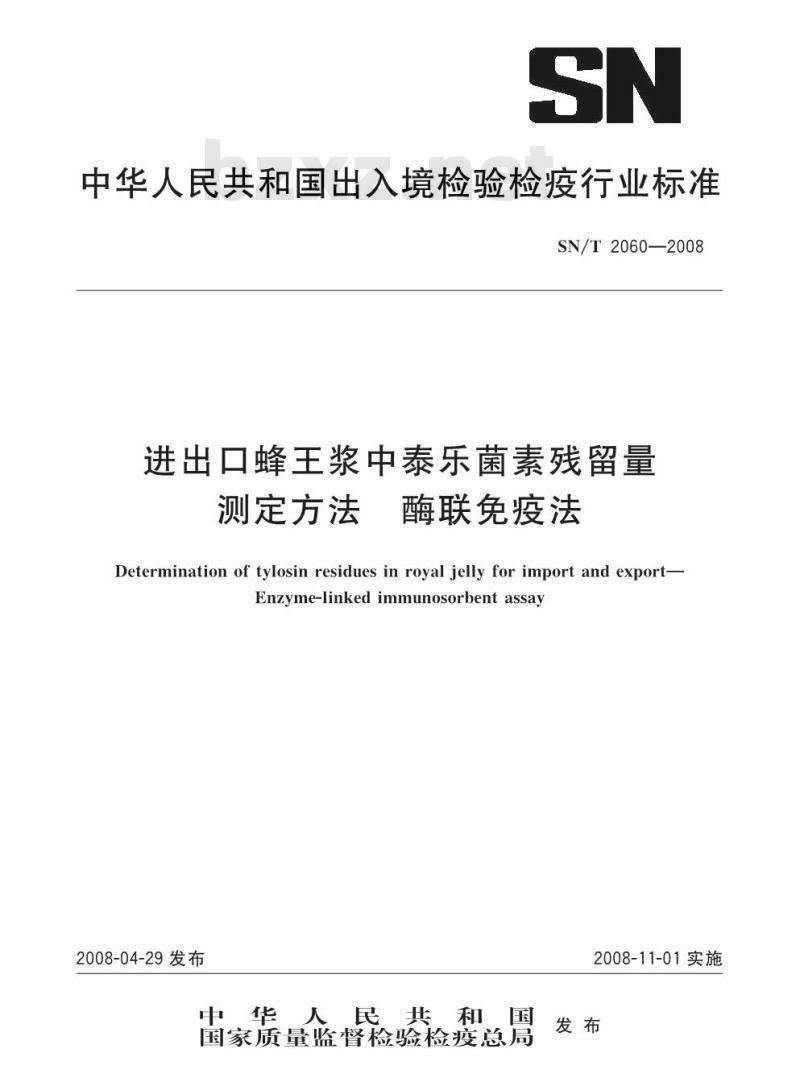
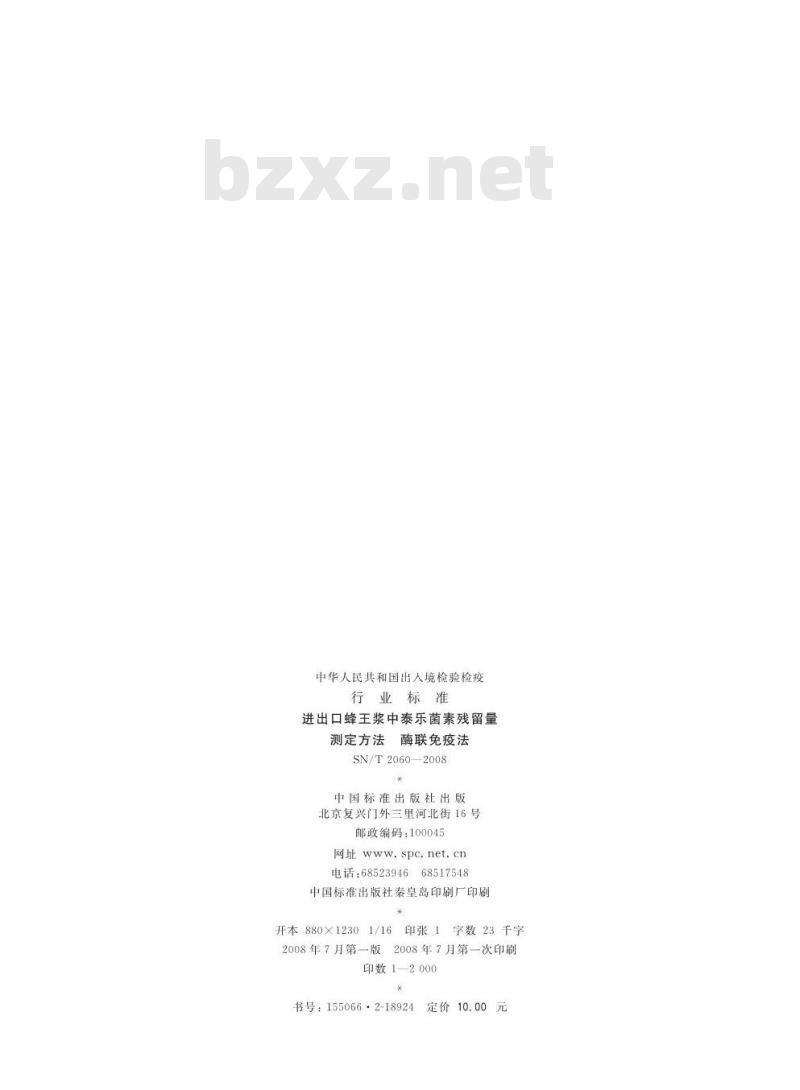
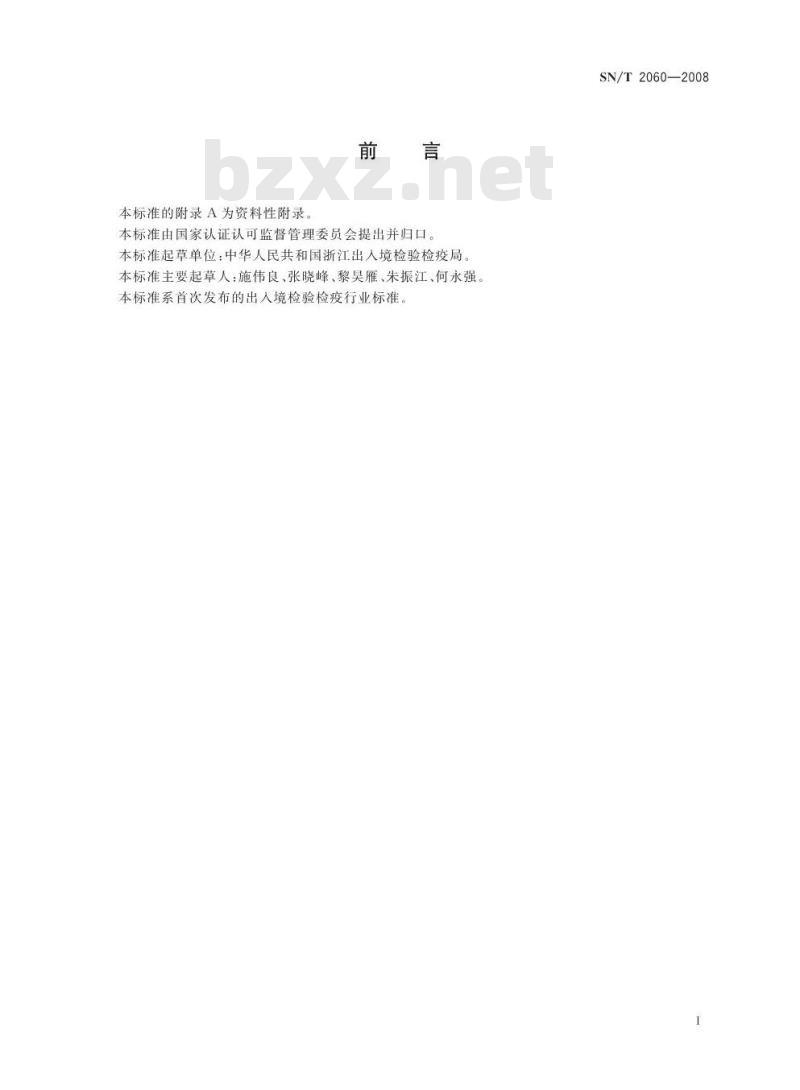
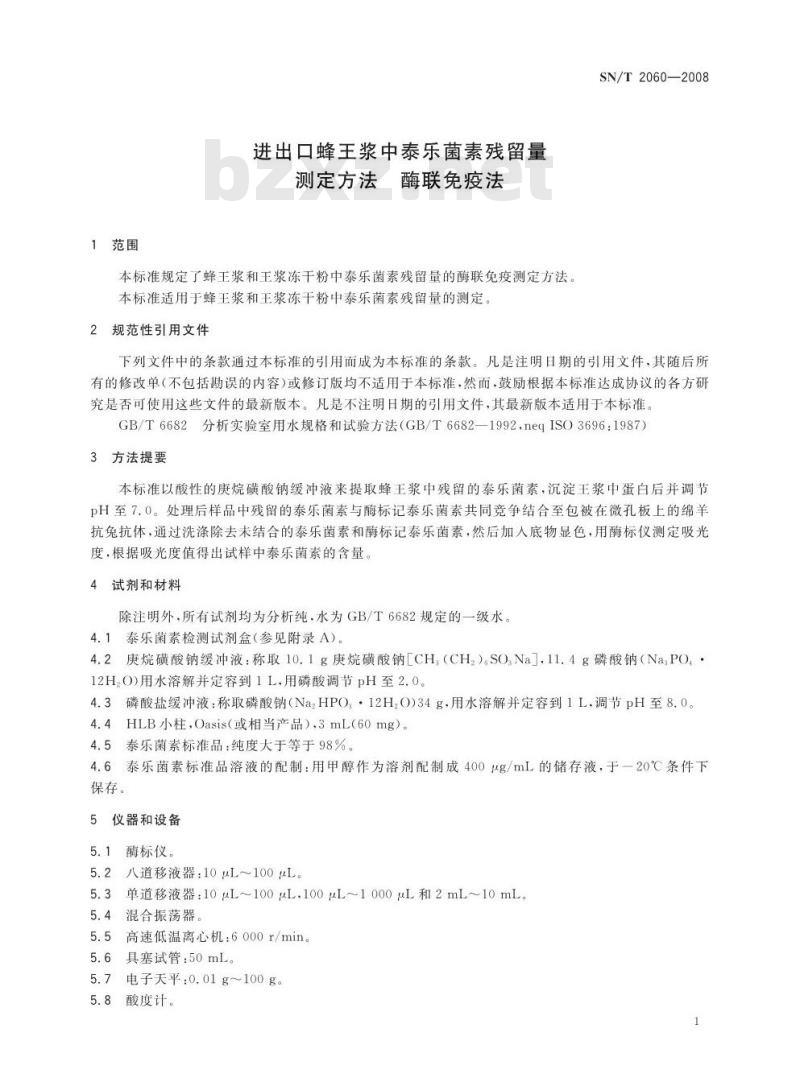
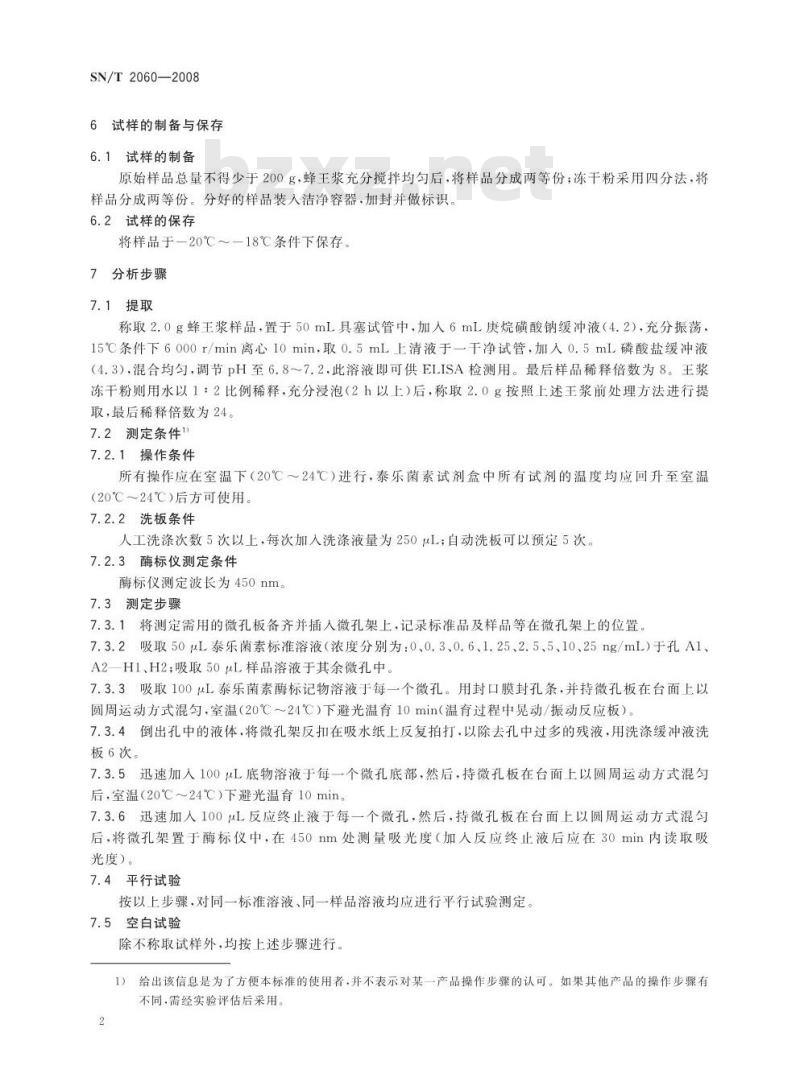
- 热门标准
- 商检行业标准(SN)
- SN/T2591.3-2010 电子电气产品中邻苯二甲酸酯类物质的测定 第3部分:高效液相色谱法
- SN/T3461-2012 植物病原菌标准样品制备要求
- SN/T0735.8-1997 出口芳香油、单离和合成香料桉叶精含量测定法
- SN/T4669-2016 进出口纺织品悬挂材料抗火焰传播性测试标准方法开 口测试箱法
- SN/T3775.3-2014 (进)出口纺织品质量符合性验证规范第3部分:纺织织物
- SN/T1621.3-2013 出口发电设备检验规程第3部分:微型(12 kW及以下)水力发电设备
- SN/T3982.9-2015 进出口纺织品质量符合性评价方法梭织服装第9部分:户外运动服装
- SN/T3274-2012 出境河蟹现场检疫监管规程
- SN/T3695.2-2014 电子电气产品中灭蚁灵的测定第2部分:气相色谱-质谱法
- SN/T5323——2021 食品接触材料高分子材料塑料中对羟基苯甲酸酯类物质迁移量的测定液相色谱串联质谱法
- SN/T4242-2015 进出口钕铁硼永磁材料中钕、镝、镨、镧、钴、硼、铝的测定电感耦合等离子体原子发射光谱法
- SN/T3714-2013 橡胶和塑料制品中钴、砷、铬、锡和铅的定量筛选方法电感耦合等离子体原子发射 光谱法
- SN/T3790-2014 出口电解金属锰粉检验规程
- SN/T3529-2013 进出口染发剂中2,4-二氨基苯酚、2,3-二氨基苯酚和2,4-二氨基苯甲醚的检测方法
- SN/T1763.3-2006 出入境口岸生物毒素检验规程 第3部分:蓖麻毒素
- 行业新闻
请牢记:“bzxz.net”即是“标准下载”四个汉字汉语拼音首字母与国际顶级域名“.net”的组合。 ©2025 标准下载网 www.bzxz.net 本站邮件:bzxznet@163.com
网站备案号:湘ICP备2025141790号-2
网站备案号:湘ICP备2025141790号-2